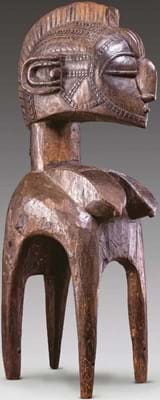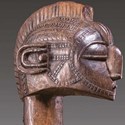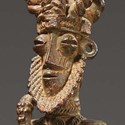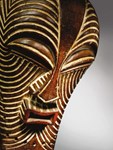Belgium has long been a major centre for tribal art and Brussels is where Lempertz (24% buyer’s premium), the Cologne-based auction house, holds regular sales of African and Oceanic items (as of 2019 in collaboration with Artcurial of Paris).
On April 9, international collectors flocked to the Belgian capital, where 350 lots were on offer in its latest sale.
Numerous items came from the estate of Mareidi Stoll, who with her husband Gert started their collection in Nigeria in the 1960s. After their return to Germany the Stolls established a gallery in Essen, then later in Munich, which specialised in the art of the Yoruba.
After Mareidi’s death in 2017, the collection was inherited by her daughter, who decided to consign it for auction (last year, several pieces were sold by Sotheby’s in Paris).
The Lempertz ensemble included more than 100 Yoruba twin figures, many of which featured in the Stolls' publication on this subject.
In Brussels consistent bidding emerged with the majority of lots selling for more than their moderate estimates. For example, a 19in (49cm) long figural title staff, the traditional sign of office of a Yoruba blacksmith, was knocked down for €3500 (£3020) – around three times the estimate.
The final lot was also from the Stoll collection and was by far and away the largest object in the sale. It was an 8ft (2.43m) high palace door of the Nupe people, neighbours to the Yoruba in Nigeria.
It was tentatively attributed to a carver from the compound of the craftsman Sakiwa in Lapai, the founder of a particularly elaborate form of relief carving and one of the few artists known by name.
The three-panel door attracted a lot of interest, selling for €18,000 (£15,520), three times the lower estimate.
Other pieces also had interesting provenances, including a 3ft 1in (94cm) high shoulder mask that went on to become the top lot of the sale.
Such carved headdresses were used at numerous ceremonies of the Baga people, who live near the coast of Guinea, such as initiations, harvest festivals or funerals. The mask once belonged to Ernst Ascher, a friend of Picasso, who established a gallery for African art in Paris in the 1920s
In 1963 it was sold by Parke-Bernet in New York to a Mrs Sheldon Tucker of Houston. After the sale Ascher wrote to the buyer, congratulating her on her purchase.
This time around, the estimate was €10,000- 15,000, but bidders from several quarters drove the price to €42,000 (£36,205).
The Wolf collection

The most expensive of a group of 20 African spoons and ladles from the collection of Ernesto Wolf and his wife Liuba was this Igbo figural example sold for €3000 (£2585) at Lempertz.
On another price level, but equally worthy of note, were the results for another part-collection that was dispersed in the auction.
Over many decades Ernesto Wolf (1918-2003) and his wife Liuba (1923-2005) amassed an impressive, multi-faceted group of medieval and Byzantine glass, modern and tribal art; much of the former donated to museums.
In 2014 Lempertz auctioned a major part of the tribal art. This time the firm offered 20 spoons and ladles from many parts of Africa, all of which found buyers for three- and four-figure prices.
The highest price in this section was achieved for a 21in (55cm) ceremonial Igbo figural spoon, which brought a top-estimate €3000 (£2585).
It is notoriously difficult to date African sculptures and experts must often rely on documentary evidence. A case in point was a pair of house posts from the Bamun (Bamoun) people of the Cameroon grasslands.
They were purchased in Cameroon by the consignor in the 1980s and are documented by a photograph in the Evangelical Missions calendar of 1951.
As they were already eroded in that photograph, it is thought that they probably date from the 1930s. The pair found a new owner for €14,000 (£12,070), just shy of the lower estimate.
£1 = €1.16



















